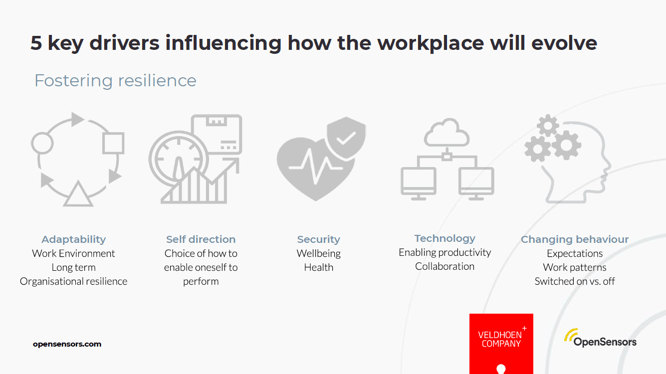Here’s what you need to consider to create a resilient workplace strategy beyond COVID19.
A collaborative approach across business units
Neither Facilities (FM) nor Corporate Real Estate (CRE) teams alone can develop robust strategies. As isolated teams, they don’t have a 360 view of how people work and what tools, skills and spaces employees require to perform at their best.
Instead, organisations should look to FM, CRE, HR & IT to collaborate and first define the intent behind planned changes to the workplace, and it is this prior understanding that determines which strategies will be successful.
The impact of COVID19
In 2020 the reason for change is clear enough: COVID19 turned our traditional work life upside down, highlighting the fragilities in the traditional office setup and accelerating existing calls for workplaces to modernise and increase flexibility as working from home switched overnight from being a luxury to a requirement.
However, the cause of an issue is not in of itself enough to define the intent behind changes; a knee-jerk reaction to COVID19 could have been to close offices permanently as businesses demonstrated their ability to function without.
So, how should we react to these circumstances? Solutions and change need purpose, and in order to implement change effectively it’s necessary to develop what we refer to as Guiding Principles which lay out the desired outcomes and the intent of change, and how these tie in to businesses’ long term goals, ethos and individual team performance.
What forces are driving change in your workplace?
Before deciding what your ideal future workplace looks like it is necessary to first address why change is needed. This means looking at which areas are currently not delivering as intended.
As a result of COVID19, many organisations are focussing on the need to foster resilience within the workplace in order to maintain productivity and business continuity as crises arise.
There are 5 key areas to focus on when creating a resilient workplace strategy
- Adaptability: the speed and ease with which an organisation can react whilst minimising the impact felt by employees and in turn customers.
- Self direction: choices surrounding how to best enable oneself to perform; workplaces need to cater to the needs of all, not just the majority.
- Security: not only the physical health of employees, but mental health too - how can organisations’ strategy give people the support they require?
- Technology: does everyone have the necessary tools and skills to enable productivity and collaboration in any setting?
- Changing behaviour: from expectations to work patterns, and top-down understanding of what is meant by ‘control’.
These are just a few of the questions teams should address before landing on a set of Guiding Principles.
Key ingredients of successful Guiding Principles
In order to define your Guiding Principles, it is vital that you consider what tangible results you are hoping to achieve, and what areas to focus on in order to facilitate this.
Below are some initial and key areas of thought
- Trust & accountability: in flexible work environments control is maintained by adopting a top down ethos of trust, support and accountability. Adopting this mentality as the starting point in your thinking allows resilient solutions to flourish.
- Facilitation & content: do we need new skills? Do we need new people, content or forms of communication in order to succeed?
- Workplace analytics: adaptability requires an in-depth understanding of what is happening in the here and now, without this you’ll be reacting too late or to incomplete information.
How do we move from intent to impact?
With these considerations in mind it is time to plan your journey from goals to implementation, following these initial steps:
Step 1: Understand the intent: what is the overall goal of our future way of work, and what guiding principles should flow through our solutions.
Step 2: Understand the implications: translate principles into specific guidelines considering how different areas - such as
Technology, Communication and the Physical workplace - will be affected.
Step 3: Understand the impact: what do chosen solutions have to deliver to address these effects?
Step 4: Understand the implementation: how and when should solutions be implemented to best deliver the results set out in the Guiding Principles?
Want to learn more?
Whether you need help with workplace analytics, consultation on your strategy or guidance on your workplace plans, we're here to help. Call us on +44 (0)20 3868 4376 or
Watch the video
Viewing time: 29mins


